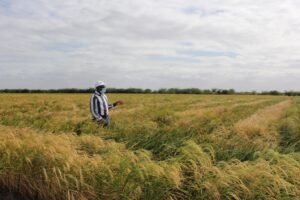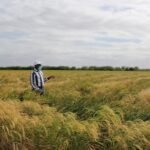By Jackson Wachira and Haro Duba, April 29, 2024, It’s only mid-morning in a small borderland village in Moyale in Kenya, but the temperature is already soaring. Globally, temperatures are rising due to human-caused global climate change.
The team of researchers from the Center for Research and Development in Drylands (CRDD), the Feinstein International Centre, Tufts University, and the Institute of Development Studies (IDS) Sussex is under a tree conversing with men from this area. A few metres away, another team is having a similar discussion with women.
They are seeking to understand how pastoralists’ knowledge, resources and networks can best contribute to effective humanitarian response and resilience to shocks and uncertainties. The conversations cover the impacts of the 2020-2023 drought, the severest in this region in two generations. They also discuss the various ways that pastoralists navigated this drought and previous ones, including how traditional early warning systems work.
According to participants, the 2020-2023 drought caused the loss of up to 80% of their cattle, precipitating extensive loss of valuable income, food and cultural identity. As a result of the severe drought, almost all the village residents rely on producing charcoal from the Prosopis Juliflora, commonly referred to as Mathenge in Kenya and Algarob in the region, to earn an income. Yet, residents recounted how this tree has brought them untold miseries due to its rapid spread and suffocation of critical grazing and living areas.
The production of charcoal from the plant has presented a new dilemma, as the communities in this region traditionally regard it as an inappropriate activity. Moreover, charcoal production is burdensome and has extremely low returns. In this village, the activity is predominantly undertaken by women, who already experience extreme time burdens due to expanding economic duties in the face of livestock loss.
The many hours required to make charcoal further constrain female well-being and may reduce their ability to provide childcare. Production of charcoal in Kenya also remains banned following the failure of recent attempts by the Kenyan Government to regulate its production and marketing. So, while Prosopis Juliflora has been a disaster for pastoralists, it has opened up opportunities for others (mostly poorer women) to earn an income as they work to re-establish their livestock holdings following the severe drought. However, this income opportunity is precarious, burdensome, illegal and frowned upon culturally.
The paradox associated with the introduction and subsequent spread of Prosopis Juliflora characterizes many interventions undertaken in Kenya’s drylands. The genesis of these interventions can be traced back to the colonial era. Colonial administrators were keen to grow the economic wherewithal of their respective empires by capitalizing on resource extraction and exploitation. Kenya’s Arid and Semi-Arid Lands (ASALs), which constitute up to 80% of the country’s land mass were viewed as wastelands with limited economic potentials to be worthy of any investments and therefore did not deserve the attention of colonial administrators.
The colonial administrators viewed the pastoral livelihood system as resistant to change, environmentally destructive and difficult to govern due to the pastoralists’ deep culture and their constant mobility. The result was the alienation of this region- consequently dubbed the Northern Frontier District–even as colonial rulers opportunistically overexploited critical resources, particularly wildlife and livestock, without commensurate compensation and reinvestments. Coupled with natural hazards such as drought, this marginalization led to widespread poverty and severely weakened ecological well-being.
The post-independence Kenyan government adopted an approach to the drylands that was virtually unchanged from that of the colonial era. This approach institutionalized an erroneous understanding of northern Kenya ASALs and pastoralism as of ‘low potential’. For instance, Sessional paper No. 10 of 1965 required the state to prioritize investments in the ‘high potential areas’(previously the white highlands) on the assumption that return on investment in these areas was guaranteed and that such returns would eventually spread to benefit the ‘low potential areas.’ This was not to be the case, in part due to deeply entrenched misgovernance and patrimonial politics.
The result was a huge disparity in the levels of development between the ‘high potential areas’ and the ‘low potential areas.’ To fill the governance and development gap, many non-governmental organizations, religious organizations, and international development actors have rolled out extensive programs to enhance access to basic services and provide repeated emergency humanitarian relief in response to shocks. Unfortunately, many of these programs have worsened rather than enhanced the lives and livelihoods of pastoralists because of their inadequate understanding of pastoral production systems and range ecology.
During discussion with the researchers, participants recounted how a foreign development professional introduced Prosopis Juliflora as a shade tree while implementing a health project in the area in the 1970s. It was in the same period that the plant was introduced in northern Kenya by influential international organizations, ostensibly to rehabilitate degraded rangelands. The communities now allege that Prosopis juliflora has negative impacts on their pay-outs from the index-based livestock insurance programs that rely on satellite imageries that ‘depict our areas as ever-green, while we, in reality, live in the misery of Prosopis.’ This perception may partly explain the continued low uptake of such products by many agrarian communities across the African continent and confounds existing concerns about their effectiveness despite their potential to complement pastoralists’ risk management practices.
At another location in Isiolo, a huge permanent building was build by the government ostensibly to provide an office space for a local resources users association. Today, only a small space is utilized as an office, while the rest of the space is used to store surplus grass and other livestock fodders. This is especially so following the enhanced 2023 rains that resulted in immense pasture regeneration. Fodder storage is a crucial adaptation strategy for pastoralists, but improper storage can result in compromised health and production or even death.
As is the case with Prosopis Juliflora, this shows how well-meaning development interventions in Kenya’s drylands fail to serve intended goals, and how this can aggravate vulnerability. They also show how pastoralists adapt and exploit these failed interventions nevertheless. However, the long-term adverse effects of these projects are long-lasting and can heavily erode pastoralists’ resilience to shocks and uncertainty. It is therefore imperative that partners adequately consider and genuinely integrate the knowledge, assets, and networks of pastoralists in the design of the development, resilience, humanitarian and early warning interventions. Before any intervention, we must think about the consequences, and make sure interventions articulate with, not undermine, pastoral livelihoods.






